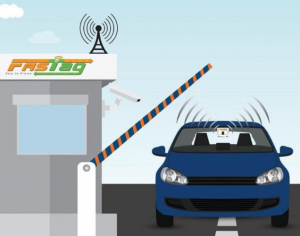FASTag payments at toll plazas from December
GST Council has also given its green signal to integrate FASTag with its e-way bill mechanism from April 1, 2020, to track the movement of trucks and plug revenue losses.
Driving on Indian highways means encountering many kinds of speed-breakers- intended and unintended. The latter category includes fellow drivers who are blase about lanes, cattle that have decided to cross the road and the toll collection plaza, where you stop every 45 minutes or so, idle behind a queue of vehicles, scrounge around for change and fob off vendors trying to sell you everything from plastic toys to potato chips. This experience is going to change from December 1, when it will become mandatory to pay tolls across India’s national highways (and several state highways) through an automated pre-paid device called FASTag, operated by a state agency. The toll barriers will electronically read the tag, deduct the toll and let your vehicle pass, thereby reducing congestion and travel time.
The radio-frequency identification (RFID) tag can be affixed to your vehicle’s windscreen and is linked to your bank account or the payment wallet of the National Highways Authority of India (NHAI). When you pass a toll, you will receive a text message specifying the amount that has been deducted. FASTag can also be used to pay fuel bills and will soon also be equipped to pay parking fees.
For many road users, FASTag is not new. They have been fitted on commercial vehicles and all new cars made since 2016- some 6.2 million vehicles in all. Currently, 1.1 million FASTag transactions amounting to Rs. 25-30 crore take place every day, about 40% of total toll volume, according to NHAI data.
The tag costs Rs. 25 and is available at banks, toll booths etc. It can also be purchased online, including on Amazon.
While the device offers undeniable convenience, it also raises concerns about privacy. Since the tag will be linked to your mobile number as well as the vehicle’s registration number, it will leave a trail of information about your journey that can be tracked. While this will help law enforcement agencies, there is bound to be concern about misuse and illegal surveillance. “When you use any digital payment, you can be tracked. This (FASTag) is no different,” says Asheesh Sharma, member (finance) of NHAI and chairman and managing director (CMD) of IHMCL, the company implementing the project. He adds that the system is devised for the convenience of road users rather than for any surveillance.
Delhi-based cyber security analyst Subimal Bhattacharjee believes the chances of illegal use of FASTag data are remote even as third parties (e.g. concessionaires) will have access to it. “The third parties are bound by the Information Technology Act, 2008, under which any violation will attract civil or even criminal provisions. If the intent of misuse is criminal, it may lead to imprisonment,” he says.
The Goods and Services Tax (GST) Council has also given its green signal to integrate FASTag with its e-way bill mechanism from April 1, 2020, to track the movement of trucks and plug revenue losses, as vehicles are at times caught making multiple trips with a single e-way bill.
Road Transport and Highways Minister Nitin Gadkari had likened FASTag to Aadhaar as he spoke at a conference on “one nation, one tag” in New Delhi last month.
In fact, the FASTag concept was first suggested in 2010 by a panel headed by Nandan Nilekani, InfosysNSE -0.20 % co-founder and technocrat who created Aadhaar, a unique identification number given to every Indian citizen. Two years later, a company, Indian Highways Management Company Ltd (IHMCL), was incorporated to roll out such a project.
But the rolling out of mandatory FASTag, initially at 525 plazas on national highways, will come with attendant challenges. Will it lead to chaos, particularly during the initial days, as many road users might not be aware of the requirement? The plan is to keep one lane open for non-FASTag users, who will have to pay double the toll as penalty.
“If a road user does not have a FASTag, she will need to pay double the toll fee under the law,” says Sharma of IHMCL. The NHAI has a 41.38% stake in the company, with the rest being held by concessionaires and financial institutions. But many states have yet to sign up for the platform and convert their toll plazas, presenting a challenge to fleet operators.
Sunil Jain, owner of Delhibased Arihant Trailer Services, explains the situation. “From Faridabad to (Gujarat’s) Mundra port, a journey of almost three days, tolls worth Rs. 7,200 have to be paid. Despite having FASTags fitted on our trucks, we need to give some cash to drivers as in several toll plazas, FASTag is still not accepted. Why can’t the government implement it uniformly, both on NHAI and state toll plazas?” Jain asks. Jain’s company has about 160 trucks.
NHAI’s Sharma answers: “We have been encouraging state governments to come on board to make ‘one nation one tag’ a reality. We have told them that we are ready to bear their capital costs as well as 80% of operational costs to make their toll plazas FASTag-enabled. I am hopeful that 8 to 10 states will come on board very soon.”
Until then, scrounging around for cash will remain a highway tradition.
Source: http://bit.ly/358MwrF





Recent Comments